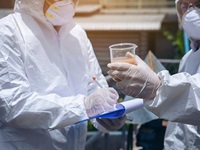The Surveillance of Wastewater to Address SARS-CoV-2 Epidemiology

Mapping the spread of SARS-CoV-2 is of utmost importance when it comes to managing the COVID-19 pandemic. Though humans may not show signs or symptoms of infection, they secrete RNA and DNA viral particles, from the oxygen they exhale to the waste they excrete. Leftover in the environment, RNA and DNA viral particles are like breadcrumbs for researchers seeking to track the spread of coronavirus.
Though there’s no standardized water testing protocol for SARS-CoV-2, a pipeline that’s ripe for monitoring the virus is our wastewater systems, as low concentrations of the virus are detectable in high volumes of wastewater and sludge.
 SARS-CoV-2 quantification from wastewater can provide valuable information that informs epidemiological studies, allows for early hotspot detection and elucidates trends of infection. Additionally, the information gained could help policymakers create early warning response systems for future pandemics.
SARS-CoV-2 quantification from wastewater can provide valuable information that informs epidemiological studies, allows for early hotspot detection and elucidates trends of infection. Additionally, the information gained could help policymakers create early warning response systems for future pandemics.
Researchers detect the virus in wastewater via cell culture methods or molecular methods.
In cell culture methods, a wastewater sample is applied to mammalian cells grown in the lab. The cells are then monitored for viral plaque growth, which signifies the presence of SARS-CoV-2.
In molecular methods, a smaller sample volume is used. Researchers employ polymerase chain reaction methods (PCR) to detect RNA and DNA viral particles in the sample. Beckman Coulter Life Sciences reagent kits are an industry standard for extracting RNA prior to PCR analysis.
We provide a suite of technological solutions that can improve methods for detecting SARS-CoV-2 in wastewater systems. From concentrating samples with our centrifuges to extracting viral RNA with our reagents, our products empower researchers to detect viral RNA at both the cellular and molecular levels.

